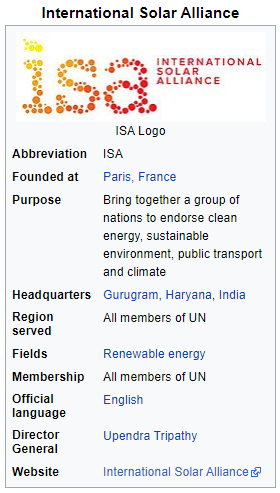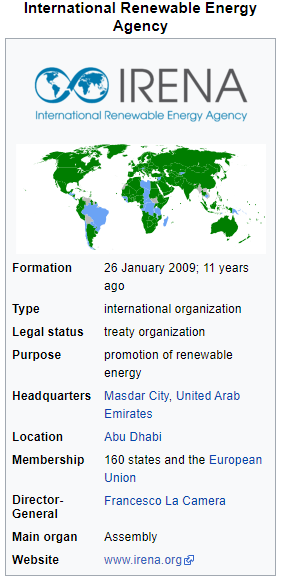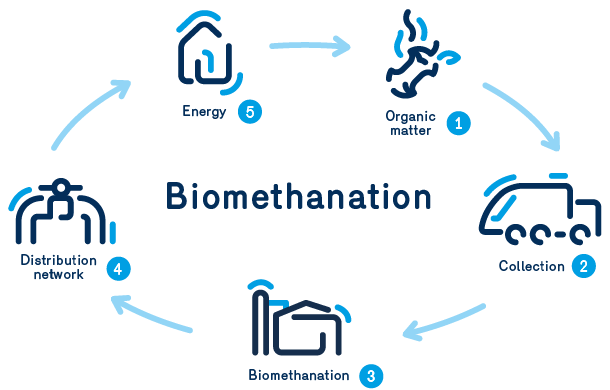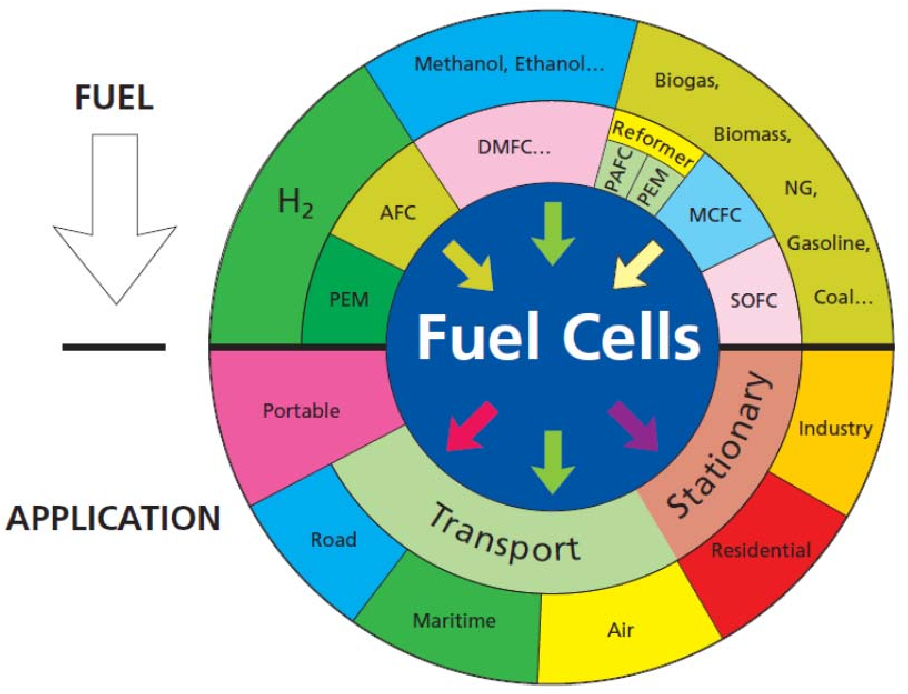The Jan 28th Static Quiz on Environment (Renewable Energy)
Quiz-summary
0 of 10 questions completed
Questions:
- 1
- 2
- 3
- 4
- 5
- 6
- 7
- 8
- 9
- 10
Information
The Jan 28th Static Quiz on Environment (Renewable Energy)
You have already completed the quiz before. Hence you can not start it again.
Quiz is loading...
You must sign in or sign up to start the quiz.
You have to finish following quiz, to start this quiz:
Results
0 of 10 questions answered correctly
Your time:
Time has elapsed
You have reached 0 of 0 points, (0)
Categories
- Not categorized 0%
- 1
- 2
- 3
- 4
- 5
- 6
- 7
- 8
- 9
- 10
- Answered
- Review
- Question 1 of 10
1. Question
The Renewable energy sources comprises of which of the folllowing?
1. Hydel energy
2. Biomass
3. Fuel cellsCorrectAns;- d) All of the above
Explanation;-
• All are part of Renewable Energy Sources.
About Renewable Energy
• Renewable energy comprises of as follows;-
1. Solar energy – energy generated from the sun
2. Hydel energy – energy derived from water
3. Biomass – energy from firewood, animal dung, biodegradable waste and crop residues, when it is burnt.
4. Geothermal energy- energy from hot dry rocks, magma, hot water springs, natural geysers, etc.
5. Ocean thermal – energy from waves and also from tidal waves.
6. Co-generation – producing two forms of energy from one fuel.
7. Fuel cells are also being used as cleaner energy source.IncorrectAns;- d) All of the above
Explanation;-
• All are part of Renewable Energy Sources.
About Renewable Energy
• Renewable energy comprises of as follows;-
1. Solar energy – energy generated from the sun
2. Hydel energy – energy derived from water
3. Biomass – energy from firewood, animal dung, biodegradable waste and crop residues, when it is burnt.
4. Geothermal energy- energy from hot dry rocks, magma, hot water springs, natural geysers, etc.
5. Ocean thermal – energy from waves and also from tidal waves.
6. Co-generation – producing two forms of energy from one fuel.
7. Fuel cells are also being used as cleaner energy source. - Question 2 of 10
2. Question
Which of the following statements about International Solar Alliance (ISA) are correct?
1. International Solar Alliance (ISA) is launched at the CoP21 Climate Conference in Paris on 30th November 2015
2. The ISA secretariat will be set up in National Institute of Solar Energy, Paris
3. It provides platform for mutual cooperation among 121 solar resource rich countries lying fully or partially between Tropic of Cancer and Tropic of Capricorn.CorrectAns;- c) Only 1 and 3
Explanation;-
• The 2nd statement is incorrect
About International Solar Alliance (ISA)
• International Solar Alliance (ISA) is launched at the CoP21 Climate Conference in Paris on 30th November as a special platform for mutual cooperation among 121 solar resource rich countries lying fully or partially between Tropic of Cancer and Tropic of Capricorn.
• The alliance is dedicated to address special energy needs of ISA member countries.
• International Agency for Solar Policy and Application (IASPA) will be the formal name of International Solar Alliance.
• The ISA secretariat will be set up in National Institute of Solar Energy, Gurgaon.
• Countries that do not fall within the Tropics can join the alliance and enjoy all benefits as other members, with the exception of voting rights.
• After the United Nations, it is the largest grouping of states world-wide.About Objectives of ISA
1. to force down prices by driving demand
2. to bring standardization in solar technologies
3. to foster research and development.• Prime Minister coined the new term “Surya Putra” for all the nations which fall between Tropic of Cancer and Tropic of Capricorn, and which have been invited to join the alliance.
• The other term used for these countries is “Sunshine Countries”. IESS 2047 stands for India Energy Security Scenarios 2047 calculator which has been launched by India to explore the potential of future energy scenarios for India. Incorrect
IncorrectAns;- c) Only 1 and 3
Explanation;-
• The 2nd statement is incorrect
About International Solar Alliance (ISA)
• International Solar Alliance (ISA) is launched at the CoP21 Climate Conference in Paris on 30th November as a special platform for mutual cooperation among 121 solar resource rich countries lying fully or partially between Tropic of Cancer and Tropic of Capricorn.
• The alliance is dedicated to address special energy needs of ISA member countries.
• International Agency for Solar Policy and Application (IASPA) will be the formal name of International Solar Alliance.
• The ISA secretariat will be set up in National Institute of Solar Energy, Gurgaon.
• Countries that do not fall within the Tropics can join the alliance and enjoy all benefits as other members, with the exception of voting rights.
• After the United Nations, it is the largest grouping of states world-wide.About Objectives of ISA
1. to force down prices by driving demand
2. to bring standardization in solar technologies
3. to foster research and development.• Prime Minister coined the new term “Surya Putra” for all the nations which fall between Tropic of Cancer and Tropic of Capricorn, and which have been invited to join the alliance.
• The other term used for these countries is “Sunshine Countries”. IESS 2047 stands for India Energy Security Scenarios 2047 calculator which has been launched by India to explore the potential of future energy scenarios for India.
- Question 3 of 10
3. Question
Which of the following statements about International Renewable Energy Agency (IRENA) are correct?
1. The International Renewable Energy Agency (IRENA) is an UN organisation that supports countries in their transition to a sustainable energy future, and serves as the principal platform for international cooperation, a centre of excellence, and a repository of policy, technology, resource and financial knowledge on renewable energy.
2. IRENA has 150 member nations with Headquarters in Abu Dhabi.CorrectAns;- b) Only 2
Explanation;-
• It is not an UN organization it is intergovernmental organization.
About IRENA
• IRENA has 150 member nations with Headquarters in Abu Dhabi.
• The International Renewable Energy Agency (IRENA) is an intergovernmental organisation that supports countries in their transition to a sustainable energy future, and serves as the principal platform for international cooperation, a centre of excellence, and a repository of policy, technology, resource and financial knowledge on renewable energy.
• IRENA promotes the widespread adoption and sustainable use of all forms of renewable energy, including bioenergy, geothermal, hydropower, ocean, solar and wind energy in the pursuit of sustainable development, energy access, energy security and low-carbon economic growth and prosperity.
• IRENA is an official United Nations observer. Incorrect
IncorrectAns;- b) Only 2
Explanation;-
• It is not an UN organization it is intergovernmental organization.
About IRENA
• IRENA has 150 member nations with Headquarters in Abu Dhabi.
• The International Renewable Energy Agency (IRENA) is an intergovernmental organisation that supports countries in their transition to a sustainable energy future, and serves as the principal platform for international cooperation, a centre of excellence, and a repository of policy, technology, resource and financial knowledge on renewable energy.
• IRENA promotes the widespread adoption and sustainable use of all forms of renewable energy, including bioenergy, geothermal, hydropower, ocean, solar and wind energy in the pursuit of sustainable development, energy access, energy security and low-carbon economic growth and prosperity.
• IRENA is an official United Nations observer.
- Question 4 of 10
4. Question
Which of the folloiwng are correctly matched about Wind farm?
a) Onshore wind farms = Construction of wind farms in large bodies of water to generate electricity. Offshore wind farms are more expensive than onshore wind farms of the same nominal power.
b) Onshore wind farms = operate on land, where the wind tends to be the strongest. The turbines of a Onshore wind farms are less expensive and easier to set up, maintain and operate than offshore turbines.CorrectAns;- d) None of the above
Explanation;-
• Both are reversed that y answer is D.
About Wind Farm
• A wind farm is a group of wind turbines in the same location used for production of electricity. A wind farm can be located onshore and offshore.
• Onshore wind farms: operate on land, where the wind tends to be the strongest. The turbines of a Onshore wind farms are less expensive and easier to set up, maintain and operate than offshore turbines.
• Offshore wind farms: Construction of wind farms in large bodies of water to generate electricity. Offshore wind farms are more expensive than onshore wind farms of the same nominal power.IncorrectAns;- d) None of the above
Explanation;-
• Both are reversed that y answer is D.
About Wind Farm
• A wind farm is a group of wind turbines in the same location used for production of electricity. A wind farm can be located onshore and offshore.
• Onshore wind farms: operate on land, where the wind tends to be the strongest. The turbines of a Onshore wind farms are less expensive and easier to set up, maintain and operate than offshore turbines.
• Offshore wind farms: Construction of wind farms in large bodies of water to generate electricity. Offshore wind farms are more expensive than onshore wind farms of the same nominal power. - Question 5 of 10
5. Question
Which of the following statements about Biomethanation are correct?
1. Biomethanation, or methanogenesis, is a scientific process whereby aerobic microorganisms in an anaerobic environment decompose biodegradable matter.
2. The three functions that take place sequentially are hydrolysis, acidogenosis and methanogenesis.CorrectAns;- b) Only 2
Explanation;-
• The 1st statements is incorrect.
Anaerobic Digestion/Biomethanation
• Biomethanation, or methanogenesis, is a scientific process whereby anaerobic microorganisms in an anaerobic environment decompose biodegradable matter producing methane-rich biogas and effluent.
• The three functions that take place sequentially are hydrolysis, acidogenosis and methanogenesis.
• It is a process by which organic material is microbiologically converted under anaerobic conditions to biogas.
• Three main physiological groups of microorganisms are involved fermenting bacteria, organic acid oxidizing bacteria, and methanogenic archaea.
• Biomethanation has strong potential for the production of energy from organic residues and wastes.
• It will help to reduce the use of fossil fuels and thus reduce CO(2) emission. Incorrect
IncorrectAns;- b) Only 2
Explanation;-
• The 1st statements is incorrect.
Anaerobic Digestion/Biomethanation
• Biomethanation, or methanogenesis, is a scientific process whereby anaerobic microorganisms in an anaerobic environment decompose biodegradable matter producing methane-rich biogas and effluent.
• The three functions that take place sequentially are hydrolysis, acidogenosis and methanogenesis.
• It is a process by which organic material is microbiologically converted under anaerobic conditions to biogas.
• Three main physiological groups of microorganisms are involved fermenting bacteria, organic acid oxidizing bacteria, and methanogenic archaea.
• Biomethanation has strong potential for the production of energy from organic residues and wastes.
• It will help to reduce the use of fossil fuels and thus reduce CO(2) emission.
- Question 6 of 10
6. Question
Which of the folloiwng statements about Pyrolysis are correct?
1. Pyrolysis is a process of chemical decomposition of organic matter brought about by cold.
2. In this process, the organic material is heated in the absence of air until the molecules thermally break down to become a gas comprising smaller moleculesCorrectAns;- d) None of the above
Explanation;-
• Both the statements are incorrect because it is heated not cooled.
About Pyrolysis
• Pyrolysis is a process of chemical decomposition of organic matter brought about by heat. In this process, the organic material is heated in the absence of air until the molecules thermally break down to become a gas comprising smaller molecules (known collectively as syngas).
• Gasification can also take place as a result of partial combustion of organic matter in the presence of a restricted quantity of oxygen or air. The gas so produced is known as producer gas.
• The gases produced by pyrolysis mainly comprise carbon monoxide (25%), hydrogen and hydrocarbons (15%), and carbon dioxide and nitrogen (60%). The next step is to ‘clean’ the syngas or producer gas.
• Thereafter, the gas is burned in internal combustion (IC) engine generator sets or turbines to produce electricity.IncorrectAns;- d) None of the above
Explanation;-
• Both the statements are incorrect because it is heated not cooled.
About Pyrolysis
• Pyrolysis is a process of chemical decomposition of organic matter brought about by heat. In this process, the organic material is heated in the absence of air until the molecules thermally break down to become a gas comprising smaller molecules (known collectively as syngas).
• Gasification can also take place as a result of partial combustion of organic matter in the presence of a restricted quantity of oxygen or air. The gas so produced is known as producer gas.
• The gases produced by pyrolysis mainly comprise carbon monoxide (25%), hydrogen and hydrocarbons (15%), and carbon dioxide and nitrogen (60%). The next step is to ‘clean’ the syngas or producer gas.
• Thereafter, the gas is burned in internal combustion (IC) engine generator sets or turbines to produce electricity. - Question 7 of 10
7. Question
Which of the following statements about Co-generation are correct?
1. Co-generation is producing two forms of energy from one fuel.
2. One of the forms of energy must always be heat and the other may be electricity or mechanical energy. In a conventional power plant, fuel is burnt in a boiler to generate high-pressure steam.CorrectAns;- c) Both 1 and 2
Explanation;-
About COGENERATION
• Co-generation is producing two forms of energy from one fuel. One of the forms of energy must always be heat and the other may be electricity or mechanical energy.
• In a conventional power plant, fuel is burnt in a boiler to generate high-pressure steam.
• This steam is used to drive a turbine, which in turn drives an alternator through a steam turbine to produce electric power.
• The exhaust steam is generally condensed to water which goes back to the boiler.
• As the low-pressure steam has a large quantum of heat which is lost in the process of condensing, the efficiency of conventional power plants is only around 35%.
• In a cogeneration plant, the low-pressure exhaust steam coming out of the turbine is not condensed, but used for heating purposes in factories or houses and thus very high efficiency levels, in the range of 75%–90%, can be reached. Since co-generation can meet both power and heat needs, it has other advantages as well in the form of significant cost savings for the plant and reduction in emissions of pollutants due to reduced fuel consumption.
• Even at conservative estimates, the potential of power generation from co-generation in India is more than 20,000 MW. Since India is the largest producer of sugar in the world, bagasse-based cogeneration is being promoted.
• The potential for cogeneration thus lies in facilities with joint requirement of heat and electricity, primarily sugar and rice mills, distilleries, petrochemical sector and industries such as fertilizers, steel, chemical, cement, pulp and paper, and aluminium.IncorrectAns;- c) Both 1 and 2
Explanation;-
About COGENERATION
• Co-generation is producing two forms of energy from one fuel. One of the forms of energy must always be heat and the other may be electricity or mechanical energy.
• In a conventional power plant, fuel is burnt in a boiler to generate high-pressure steam.
• This steam is used to drive a turbine, which in turn drives an alternator through a steam turbine to produce electric power.
• The exhaust steam is generally condensed to water which goes back to the boiler.
• As the low-pressure steam has a large quantum of heat which is lost in the process of condensing, the efficiency of conventional power plants is only around 35%.
• In a cogeneration plant, the low-pressure exhaust steam coming out of the turbine is not condensed, but used for heating purposes in factories or houses and thus very high efficiency levels, in the range of 75%–90%, can be reached. Since co-generation can meet both power and heat needs, it has other advantages as well in the form of significant cost savings for the plant and reduction in emissions of pollutants due to reduced fuel consumption.
• Even at conservative estimates, the potential of power generation from co-generation in India is more than 20,000 MW. Since India is the largest producer of sugar in the world, bagasse-based cogeneration is being promoted.
• The potential for cogeneration thus lies in facilities with joint requirement of heat and electricity, primarily sugar and rice mills, distilleries, petrochemical sector and industries such as fertilizers, steel, chemical, cement, pulp and paper, and aluminium. - Question 8 of 10
8. Question
Which of the folloiwng statements are correct about Fuel cells?
1. Fuel cells are electrochemical devices that convert the chemical energy of a fuel directly and very efficiently into electricity (AC) and heat.
2. The most suitable fuel for such cells is hydrogen or a mixture of compounds containing hydrogen.CorrectAns;- b) Only 2
Explanation;-
• The 1st statement is incorrect because it is DC not AC.
About Fuel Cells
• Fuel cells are electrochemical devices that convert the chemical energy of a fuel directly and very efficiently into electricity (DC) and heat, thus doing away with combustion.
• The most suitable fuel for such cells is hydrogen or a mixture of compounds containing hydrogen.
• A fuel cell consists of an electrolyte sandwiched between two electrodes.
• Oxygen passes over one electrode and hydrogen over the other, and they react electrochemically to generate electricity, water, and heat. Incorrect
IncorrectAns;- b) Only 2
Explanation;-
• The 1st statement is incorrect because it is DC not AC.
About Fuel Cells
• Fuel cells are electrochemical devices that convert the chemical energy of a fuel directly and very efficiently into electricity (DC) and heat, thus doing away with combustion.
• The most suitable fuel for such cells is hydrogen or a mixture of compounds containing hydrogen.
• A fuel cell consists of an electrolyte sandwiched between two electrodes.
• Oxygen passes over one electrode and hydrogen over the other, and they react electrochemically to generate electricity, water, and heat.
- Question 9 of 10
9. Question
Which of the following are the major sites for geothermal energy in India?
1. Tattapani spring = Jharkhand
2. Sohana = Haryana
3. Mahanadi = orissaCorrectAns;- b) Only 2 and 3
Explanation;-
• The 1st is incorrect because it is in Chhatisgarh
About Geothermal Energy in India
• In India, exploration and study of geothermal fields started in 1970. The GSI (Geological Survey of India) has identified 350 geothermal energy locations in the country. The most promising of these is in Puga valley of Ladakh. The estimated potential for geothermal energy in India is about 10000 MW.
• The major sites for geothermal energy are:
• Himalayas: J&K, HP and Sikkim; PUGA hot spring in J&K and Manikaran in HP.
• Sohana: Haryana, Rajasthan.
• Son-Narmada-Tapi (SONATA): MP, Chhattisgarh and Jharkhand; Tattapani spring in Chhattisgarh.
• Cambay: Mainly Gujarat and some parts of Rajasthan
• Godavari: AP
• Mahanadi: Orissa, Taptapani Spring in Orissa.About Government Initiatives
• First Geothermal power plant to come in Chhattisgarh by joint cooperation of NTPC and Chhattisgarh Renewable Energy Development Agency (CREDA). Tattapani geothermal field in SONATA geothermal province.
• For Industrial Projects, government has planned to provide capital subsidy of up to 30%.
• Ministry of New and Renewable Energy (MNRE) provides large incentives and subsidies for Research, Design, Development and Demonstration (RDD&D) for harnessing geothermal energy in India.
• Ministry of renewable energy has planned to generate geothermal energy up to 1000 MW by 2022.
• As per Geological Survey of India (GSI), 10000 MW geothermal potential has been identified in India.IncorrectAns;- b) Only 2 and 3
Explanation;-
• The 1st is incorrect because it is in Chhatisgarh
About Geothermal Energy in India
• In India, exploration and study of geothermal fields started in 1970. The GSI (Geological Survey of India) has identified 350 geothermal energy locations in the country. The most promising of these is in Puga valley of Ladakh. The estimated potential for geothermal energy in India is about 10000 MW.
• The major sites for geothermal energy are:
• Himalayas: J&K, HP and Sikkim; PUGA hot spring in J&K and Manikaran in HP.
• Sohana: Haryana, Rajasthan.
• Son-Narmada-Tapi (SONATA): MP, Chhattisgarh and Jharkhand; Tattapani spring in Chhattisgarh.
• Cambay: Mainly Gujarat and some parts of Rajasthan
• Godavari: AP
• Mahanadi: Orissa, Taptapani Spring in Orissa.About Government Initiatives
• First Geothermal power plant to come in Chhattisgarh by joint cooperation of NTPC and Chhattisgarh Renewable Energy Development Agency (CREDA). Tattapani geothermal field in SONATA geothermal province.
• For Industrial Projects, government has planned to provide capital subsidy of up to 30%.
• Ministry of New and Renewable Energy (MNRE) provides large incentives and subsidies for Research, Design, Development and Demonstration (RDD&D) for harnessing geothermal energy in India.
• Ministry of renewable energy has planned to generate geothermal energy up to 1000 MW by 2022.
• As per Geological Survey of India (GSI), 10000 MW geothermal potential has been identified in India. - Question 10 of 10
10. Question
Which of the following about Incineration are correct?
1. In this process, waste is directly burned in the presence of excess air (oxygen) at high temperatures
2. Combustion results in transfer of 65–80% of heat content of the organic matter to hot air, steam and hot water.CorrectAns;- c) Both 1 and 2
Explanation;-
• Both are correct.
About Combustion/Incineration
• In this process, waste is directly burned in the presence of excess air (oxygen) at high temperatures (about 800°C), liberating heat energy, inert gases and ash.
• Combustion results in transfer of 65–80% of heat content of the organic matter to hot air, steam and hot water. The steam generated, in turn, can be used in steam turbines to generate power.IncorrectAns;- c) Both 1 and 2
Explanation;-
• Both are correct.
About Combustion/Incineration
• In this process, waste is directly burned in the presence of excess air (oxygen) at high temperatures (about 800°C), liberating heat energy, inert gases and ash.
• Combustion results in transfer of 65–80% of heat content of the organic matter to hot air, steam and hot water. The steam generated, in turn, can be used in steam turbines to generate power.







